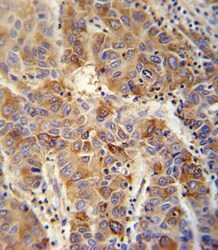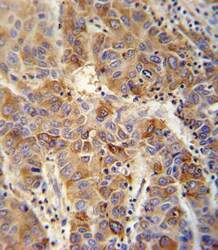Antibody data
- Antibody Data
- Antigen structure
- References [0]
- Comments [0]
- Validations
- Western blot [2]
- Immunohistochemistry [2]
Submit
Validation data
Reference
Comment
Report error
- Product number
- PA5-25755 - Provider product page

- Provider
- Invitrogen Antibodies
- Product name
- VAMP4 Polyclonal Antibody
- Antibody type
- Polyclonal
- Antigen
- Synthetic peptide
- Description
- This antibody is predicted to react with bovine based on sequence homology.
- Reactivity
- Human, Mouse
- Host
- Rabbit
- Isotype
- IgG
- Vial size
- 400 μL
- Concentration
- 0.45 mg/mL
- Storage
- Store at 4°C short term. For long term storage, store at -20°C, avoiding freeze/thaw cycles.
No comments: Submit comment
Supportive validation
- Submitted by
- Invitrogen Antibodies (provider)
- Main image

- Experimental details
- Western blot analysis of VAMP4 in K562 cell line lysates. Samples were incubated with VAMP4 polyclonal antibody (Product # PA5-25755). Lysates: 35 µg/lane. the VAMP4 protein (arrow).
- Submitted by
- Invitrogen Antibodies (provider)
- Main image

- Experimental details
- Western blot analysis of VAMP4 in mouse liver tissue lysates. Samples were incubated with VAMP4 polyclonal antibody (Product # PA5-25755). Lysates: 35 µg/lane. the VAMP4 protein (arrow).
Supportive validation
- Submitted by
- Invitrogen Antibodies (provider)
- Main image

- Experimental details
- Immunohistochemistry analysis of VAMP4 in formalin fixed and paraffin embedded human hepatocarcinoma. Samples were incubated with VAMP4 polyclonal antibody (Product # PA5-25755) followed by peroxidase conjugation of the secondary antibody and DAB staining. This data demonstrates the use of this antibody for immunohistochemistry. Clinical relevance has not been evaluated.
- Submitted by
- Invitrogen Antibodies (provider)
- Main image

- Experimental details
- Immunohistochemistry analysis of VAMP4 in formalin fixed and paraffin embedded human hepatocarcinoma. Samples were incubated with VAMP4 polyclonal antibody (Product # PA5-25755) followed by peroxidase conjugation of the secondary antibody and DAB staining. This data demonstrates the use of this antibody for immunohistochemistry. Clinical relevance has not been evaluated.
 Explore
Explore Validate
Validate Learn
Learn Western blot
Western blot